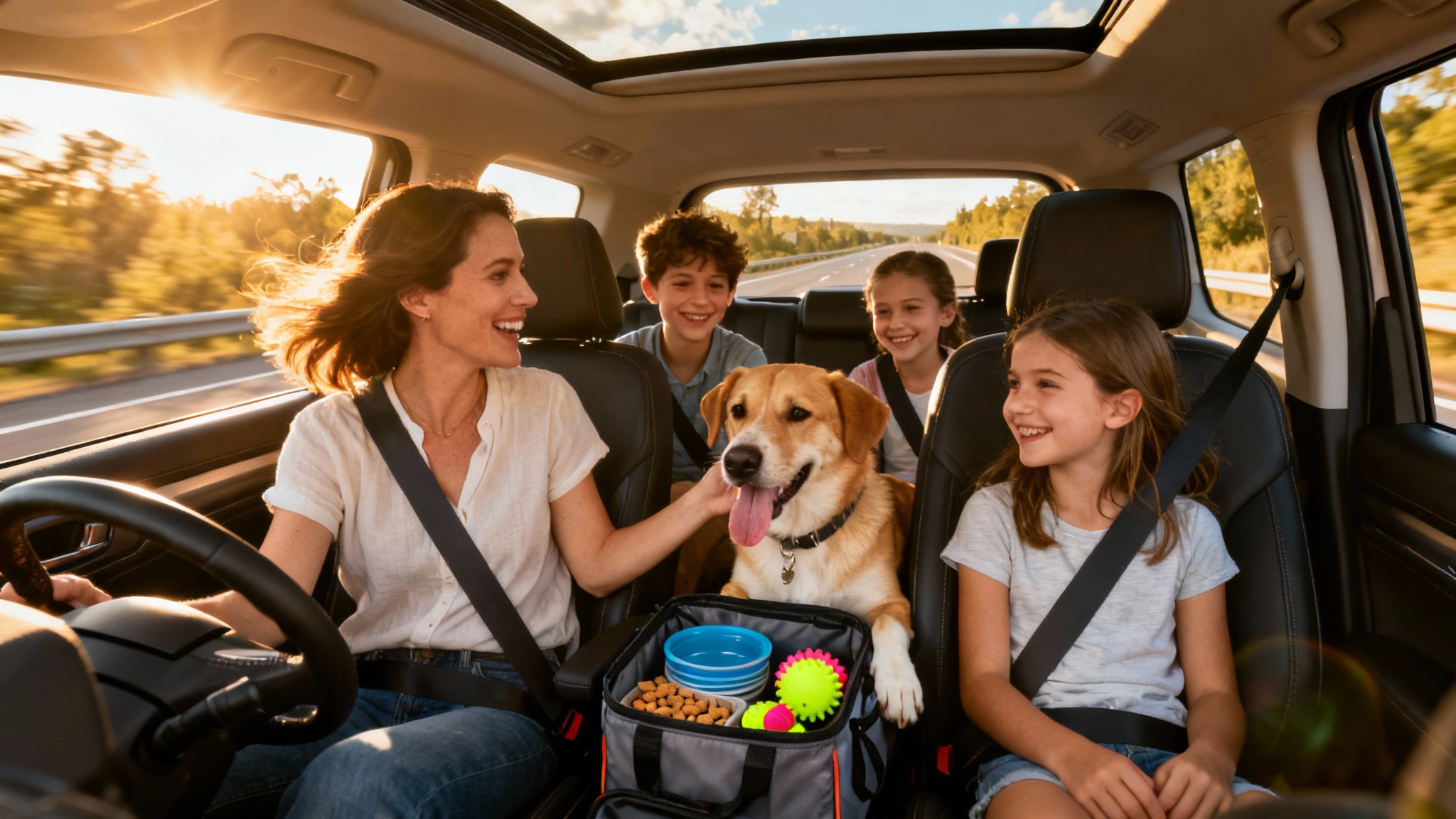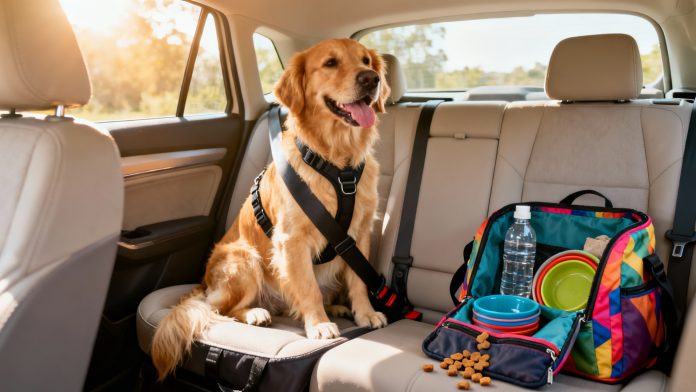Introduction:
Traveling with a dog can be fun in all aspects, but it often brings its own set of challenges. Cars in general can really upset animals; anybody can see that. With a bit of planning, treats become more than snacks. Everything becomes part of a math problem, and their environment becomes a desk.
Early preparation makes the difference between a stressful outing and an enjoyable adventure. Simple tools, such as favorite snacks, hydration solutions, and calming chews for dogs, allow pets to remain at ease in unfamiliar situations. Understanding what works best can make travelling more enjoyable for both pet and parent.
This guide expands your original outline into a friendly, practical playbook. You will learn how to select travel-smart treats, use them to reduce anxiety, balance nutrition with indulgence, and pair snacks with simple training games that make moving from driveway to destination a whole lot easier.
The Role of Treats in Comfortable Travel
Treats do three big jobs on the road: they reward, they soothe, and they redirect. That makes them valuable from the moment you zip the carrier to the moment you unlock the hotel room.
How do treats change feelings in new places?
Dogs form associations quickly. Offer something delicious while the car starts, the elevator dings, or the jet engines spool, and you are teaching that these sounds predict good things. Over time, your pup learns that novel equals safe.
Moments worth treating (and why)
-
Load-in and buckling up: create a calm start ritual
-
Security checks and boarding lines: focus beats fidgeting
-
Takeoff, landing, or bumpy roads: lickable treats encourage steady breathing
-
Hotel door opens: reinforce quiet curiosity instead of door-dashing
Choosing the Right Travel Treats
Not all snacks behave well in motion. Some crumble, smear, or spoil. For travel, you want compact, clean, and high-value.
Qualities to look for
-
Dry or semi-moist texture to avoid sticky hands or car seats
-
High aroma so your dog can focus even in noisy settings.
-
Short ingredient list for easy digestion on the road.
-
You get small rewards quickly by breaking the pieces.
Formats that earn their seatbelt
-
Bite-size training treats: rapid reinforcement without calorie overload
-
Lickable tubes or pouches: great for distraction during stress spikes
-
Long-lasting chews: safe, size-appropriate options for car downtime
-
Calming chews for dogs: Use only as directed; introduce at home first
Pro tip: rotate two flavors (for example, savory and lightly sweet) so your dog stays interested during long days.
Treats as Distractions During Transit
Different legs of the journey require different strategies. The theme is the same: predictable patterns that make travel feel routine.

Car travel: smooth rides and steady focus
-
Pre-drive snack test: a nibble 30 to 60 minutes before leaving gauges stomach tolerance
-
Seatbelt harness or secured crate: treat for quiet sits and relaxed down-stays
-
Scheduled chew time: offer a longer chew once you are at cruising speed
-
Rest-stop rituals: brief walk, water, potty, two treats for returning to the car calmly
Air travel: crowds, carriers, and cabin noise
-
Carrier conditioning at home: scatter tiny treats inside and let your dog choose to enter
-
Security line manners: a lickable pouch keeps noses and paws where you want them
-
Takeoff and landing: slow licking can help relax facial muscles and steady breathing
-
In-flight: small, periodic nibbles beat a single big snack
Trains, ferries, and public spaces
-
Mat “place” game: treat any glance or lie-down on the mat while you wait on platforms
-
Thresholds and elevators: one treat per calm step forward; slow is smooth
Balancing Nutrition and Indulgence
Treats help travel feel safe, but too much can upset tummies. A little math avoids mid-journey regrets.
Healthier options include low-fat, protein-rich choices or treats with added vitamins. Always check ingredient lists before trips, as some artificial additives can worsen sensitivity during stressful journeys. A balance of fun and nutrition makes treats both enjoyable and beneficial.
Portion planning
-
Keep treats to no more than 10 percent of daily calories unless your vet advises otherwise.
-
Pre-pack day bags: AM, midday, PM portions so you do not over-share in the moment
-
Choose high-protein, low-fat options for sensitive stomachs
Sample day on the road (adjust to your dog)
-
Wake-up: 2 to 4 tiny training treats for calm leash clip and lobby walk
-
En route: 1 long chew at cruising speed; two short training sessions with 5 to 10 tiny rewards
-
Arrival: 3 to 6 small treats for exploring the room quietly and settling on the mat
If your dog is new to car or air travel, test your treat plan at home and on short drives first.
Practical Prep That Multiplies the Power of Treats
Treats work best inside a simple, repeatable routine.
Pack these essentials
-
Collapsible water bowl and bottled water
-
Two types of treats: quick bites and a long chew
-
Resealable pouches or tins to keep snacks fresh
-
Poop bags, enzyme cleaner, and a small towel
-
A mat or a familiar blanket that smells like home
-
Copy of vaccination records and vet contacts
Introduce before you go.
-
Offer any new treat at home for a few days; watch for GI tolerance
-
Practice the “settle on mat” behavior with tiny rewards so it is ready for terminals and hotel lobbies
-
Let the travel crate live open in your living room for a week with surprise treats inside
Training Games That Make Travel Easier
Short, upbeat games turn treats into reliable behaviors you can use anywhere.
Settle on a Mat
Mark and treat any glance at the mat. Build to a full down-stay. This becomes your portable calm button for gates, lounges, and cafes.
Target to Hand
Teach your dog to boop your palm with their nose. Use it to steer gently through crowds or past distractions, paying with tiny treats.
Look at That
When your dog notices a trigger (roller bag, cart, loudspeaker), say “Yes,” deliver a treat. Soon, your dog will check in with you when surprises appear.
Troubleshooting Common Travel Hurdles
Motion sickness
Ask your vet about options if your dog drools or vomits. Feed a light meal 3 to 4 hours pre-drive. Choose low-fat, bland treats during travel.
Refuses treats on the road
Stress suppresses appetite. Try higher-value aromas, lickable pouches, or softer textures. Increase the distance from the trigger and reward any calm glance back to you.
Over-arousal in lobbies or lines
Switch to a treat scatter on the mat (tiny pieces spread out) to encourage nose-down sniffing, which helps many dogs decompress.
Safety and Etiquette Notes
-
Vet first: discuss calming chews for dogs or supplements before use
-
Allergies: stick to known proteins on travel days
-
Hygiene: hand wipes and treat tins keep things tidy in shared spaces
-
Respect rules: confirm pet policies for hotels, airlines, trains, and border crossings; some countries restrict animal products
Frequently Asked Questions
How many treats can I give my dog during a travel day?
Aim for no more than 10 percent of daily calories from treats. Pre-portion into small bags so you can reward often without overfeeding.
Are calming chews safe for travel days?
Many pets tolerate them well, but always introduce them at home and ask your veterinarian, especially if your dog takes medication or has a medical condition.
What if my dog will not eat in the car or on a plane?
Use extra-aromatic, soft treats or lickable pouches. Increase distance from stressors and reward any small sign of relaxation. Appetite usually returns as your dog acclimates.
Should I withhold breakfast before a long drive?
For sensitive stomachs, a light meal 3 to 4 hours pre-drive often helps. Confirm timing with your vet.
What treats work best at security checkpoints?
Fast-to-deliver bite-size rewards or a small lickable pouch keep focus without mess. Practice “touch” and “mat” at home to cut down fumbling.
How do I prevent weight gain while traveling?
Reduce meal portions slightly if you plan to use more treats, and choose low-calorie training bites. Keep walks and sniff breaks on schedule.
Are rawhide or hard chews okay for the car?
Avoid anything that risks choking or heavy splintering. Pick size-appropriate, digestible chews and supervise from the next seat.
Can I bring treats through airport security?
Dry treats typically pass through domestic security; international travel may restrict animal products. Check the route and destination rules in advance.
What if my dog guards treats in tight spaces?
Skip long-lasting chews in crowded settings. Use tiny training bites delivered for calm behavior and practice “trade” at home.
My dog barks in the hotel room. Can treats help?
Yes. Create an arrival routine: potty break, short sniff walk, settle on the mat, quiet treat scatter, then a longer chew when calm. White-noise and a covered crate can also help.
Conclusion: Plan the Snacks, Enjoy the Journey
Treats turn travel from unpredictable to practiced. Choose travel-smart snacks, pre-portion to protect tummies, and pair each leg of the trip with a simple reward pattern. Put a mat down, some water on it, and two short training games with your dog, and you have a calm-first routine anywhere. By being prepared and having patience, treats will make a strange place feel like a normal experience, and any mile is an adventure.

